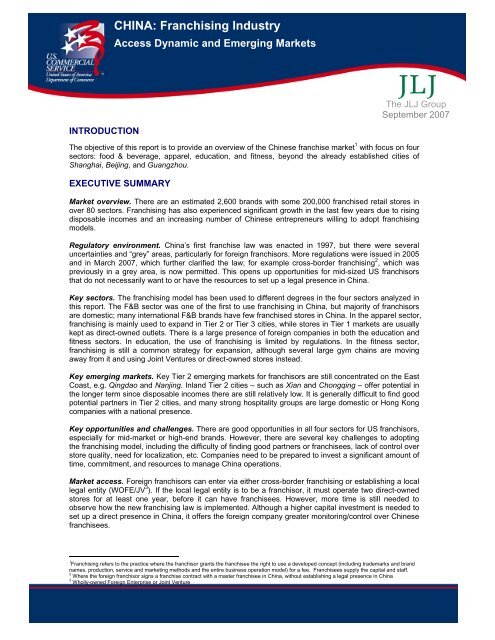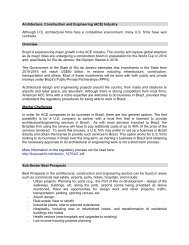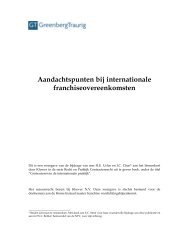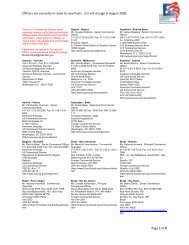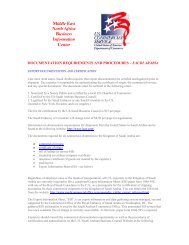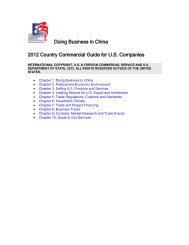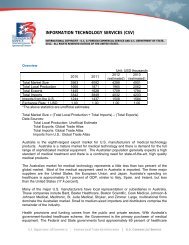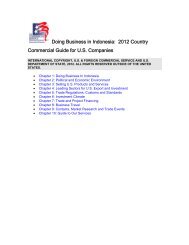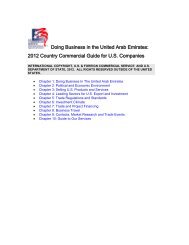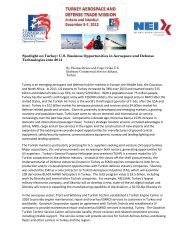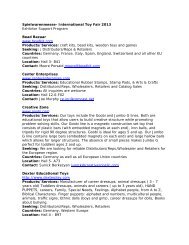CHINA: Franchising Industry - Export.gov
CHINA: Franchising Industry - Export.gov
CHINA: Franchising Industry - Export.gov
Create successful ePaper yourself
Turn your PDF publications into a flip-book with our unique Google optimized e-Paper software.
INTRODUCTION<br />
<strong>CHINA</strong>: <strong>Franchising</strong> <strong>Industry</strong><br />
Access Dynamic and Emerging Markets<br />
US Commercial Service – The JLJ Group<br />
China <strong>Franchising</strong> <strong>Industry</strong><br />
Page 1 of 23<br />
The objective of this report is to provide an overview of the Chinese franchise market 1 with focus on four<br />
sectors: food & beverage, apparel, education, and fitness, beyond the already established cities of<br />
Shanghai, Beijing, and Guangzhou.<br />
EXECUTIVE SUMMARY<br />
Market overview. There are an estimated 2,600 brands with some 200,000 franchised retail stores in<br />
over 80 sectors. <strong>Franchising</strong> has also experienced significant growth in the last few years due to rising<br />
disposable incomes and an increasing number of Chinese entrepreneurs willing to adopt franchising<br />
models.<br />
Regulatory environment. China’s first franchise law was enacted in 1997, but there were several<br />
uncertainties and “grey” areas, particularly for foreign franchisors. More regulations were issued in 2005<br />
and in March 2007, which further clarified the law; for example cross-border franchising 2 , which was<br />
previously in a grey area, is now permitted. This opens up opportunities for mid-sized US franchisors<br />
that do not necessarily want to or have the resources to set up a legal presence in China.<br />
Key sectors. The franchising model has been used to different degrees in the four sectors analyzed in<br />
this report. The F&B sector was one of the first to use franchising in China, but majority of franchisors<br />
are domestic; many international F&B brands have few franchised stores in China. In the apparel sector,<br />
franchising is mainly used to expand in Tier 2 or Tier 3 cities, while stores in Tier 1 markets are usually<br />
kept as direct-owned outlets. There is a large presence of foreign companies in both the education and<br />
fitness sectors. In education, the use of franchising is limited by regulations. In the fitness sector,<br />
franchising is still a common strategy for expansion, although several large gym chains are moving<br />
away from it and using Joint Ventures or direct-owned stores instead.<br />
Key emerging markets. Key Tier 2 emerging markets for franchisors are still concentrated on the East<br />
Coast, e.g. Qingdao and Nanjing. Inland Tier 2 cities – such as Xian and Chongqing – offer potential in<br />
the longer term since disposable incomes there are still relatively low. It is generally difficult to find good<br />
potential partners in Tier 2 cities, and many strong hospitality groups are large domestic or Hong Kong<br />
companies with a national presence.<br />
Key opportunities and challenges. There are good opportunities in all four sectors for US franchisors,<br />
especially for mid-market or high-end brands. However, there are several key challenges to adopting<br />
the franchising model, including the difficulty of finding good partners or franchisees, lack of control over<br />
store quality, need for localization, etc. Companies need to be prepared to invest a significant amount of<br />
time, commitment, and resources to manage China operations.<br />
Market access. Foreign franchisors can enter via either cross-border franchising or establishing a local<br />
legal entity (WOFE/JV 3 ). If the local legal entity is to be a franchisor, it must operate two direct-owned<br />
stores for at least one year, before it can have franchisees. However, more time is still needed to<br />
observe how the new franchising law is implemented. Although a higher capital investment is needed to<br />
set up a direct presence in China, it offers the foreign company greater monitoring/control over Chinese<br />
franchisees.<br />
1 <strong>Franchising</strong> refers to the practice where the franchisor grants the franchisee the right to use a developed concept (including trademarks and brand<br />
names, production, service and marketing methods and the entire business operation model) for a fee. Franchisees supply the capital and staff.<br />
2 Where the foreign franchisor signs a franchise contract with a master franchisee in China, without establishing a legal presence in China<br />
3 Wholly-owned Foreign Enterprise or Joint Venture<br />
The JLJ Group<br />
September 2007
US Commercial Service – The JLJ Group<br />
China <strong>Franchising</strong> <strong>Industry</strong><br />
Page 2 of 23<br />
INDUSTRY OVERVIEW Return to Top<br />
Market overview. China has 2,600 franchise networks 4 operating in the first quarter of 2007 and over<br />
200,000 franchised outlets. However, many of these franchises are domestic brands and small in scale,<br />
with an average of 73 outlets per franchise brand 5 , compared to over 540 in the US. The limited use of<br />
franchised stores also reflects the key challenges to adopt this model, for example, regional differences<br />
and quality of local franchisees/partners.<br />
Market growth. Growth in sales from franchised stores has averaged 35-40% in the last few years. In<br />
2006, sales from franchised outlets grew by 40%, compared to 10% for retail outlets in general.<br />
Currently, franchising in China only accounts for 3% of total retail sales – compared to 40% in the US<br />
and about 10% on average in Europe. Thus, there is still significant growth potential in franchising.<br />
Drivers of growth. On the demand side, growth is driven by an expanding consumer market, a<br />
developing urban middle class, rising disposable incomes, and changing customer attitudes. On the<br />
supply side, an increasing number of Chinese companies are using the franchising model to expand.<br />
Also, more Chinese entrepreneurs are willing to be franchisees for foreign brands, and have the<br />
financial resources to do so. In addition, the Chinese market has become more attractive to foreign<br />
franchisors since the regulations newly introduced in March 2007 address many previous issues that<br />
were unclear in the previous regulations. [see section on Regulatory Environment for more details.]<br />
Key sectors. The franchising model is adopted in over 80 sectors. In 2005, 34% of franchised stores<br />
were in food and catering, 31% in retailing, and 35% in the service (includes laundry, property agents,<br />
copy-shops, etc.) sector. Companies with existing chain stores 6 have used franchising to expand – 69%<br />
of chains adopted the franchising model at the start of 2007. In particular, fast food chains rely heavily<br />
on franchising – 95% have used franchising to expand.<br />
35%<br />
Franchised Stores by Sector<br />
34%<br />
Source: Ministry of Commerce<br />
31%<br />
Retail<br />
Food & Catering<br />
Services<br />
Regulatory Environment Return to Top<br />
Regulatory developments. China’s first franchise law was enacted in 1997 by the Ministry of Domestic<br />
Trade, which did not make clear provisions for foreign companies. In 2005, the Ministry of Commerce<br />
(MOFCOM) released hastily – due to WTO commitments – drafted measures applicable specifically to<br />
foreign franchisors. This document confirmed that foreign companies must establish a legal entity in<br />
China before they can engage in franchising; however many other issues were still unclear, including<br />
the legality of cross-border franchising. In March 2007, further updates (“The Regulations”, “The Record<br />
Filing Measures” and “The Information Disclosure Measures”) to the existing regulations were<br />
announced, which addressed many of the grey areas. These new amendments form the new regulatory<br />
framework for franchising. The following are the most important aspects of the updated regulation. It<br />
must be noted that these May 2007 regulations are still relatively new, and more time is needed to see<br />
the actual implementation.<br />
4 Refers to a system of franchisees under the same network. A franchise brand may have more than one franchise network, e.g. it has a few<br />
regional master franchisees, which in turn further sub-franchise.<br />
5 Includes China’s large franchise brands, with thousands of outlets, as well as the multitude of small brands, with only a few outlets each.<br />
6 While franchises are always chain stores, the opposite does not hold true.
US Commercial Service – The JLJ Group<br />
China <strong>Franchising</strong> <strong>Industry</strong><br />
Page 3 of 23<br />
Cross-border franchising. Cross-border franchising, whereby foreign franchisors engage a master<br />
franchisee in China without setting up a local legal entity, was previously in a “grey” area - old<br />
regulations mandated franchisors to set up a legal presence and operate at least two stores in China<br />
before franchising; however, some foreign companies still entered via cross-border franchising. With<br />
the newly updated law, this practice is now fully legal. The franchisor still needs to have at least two<br />
successful stores, but these do not have to be in China. According to MOFCOM, several franchisors<br />
have already entered using this method since May 2007 7 .<br />
Operating in China. Although cross-border franchising is allowed, for companies which choose to set<br />
up a legal entity in China, they are still subject to the relevant company laws. Thus the Chinese legal<br />
entity has to operate two successful stores for at least one year, before it can be a franchisor [more<br />
details in section on Market Access]<br />
Key Franchise Sectors & Competitive Landscape Return to Top<br />
The following sections of the report focus on four sectors: 1) Food & Beverage; 2) Apparel; 3) Education<br />
and 4) Fitness. <strong>Franchising</strong> is adopted in all four sectors, but the presence of foreign franchises differs<br />
depending on sector. Table 1 compares foreign to domestic franchises for these sectors.<br />
Domestic vs. foreign brands. In general, domestic franchise brands outnumber foreign brands.<br />
However, many domestic outlets suffer from poor standardization and consistency across their outlets.<br />
Foreign brands are well-accepted, but have the widest presence in Tier 1 cities, where a large brand<br />
can have dozens of outlets per city, compared to about 1-4 outlets for each Tier 2 city.<br />
<strong>Franchising</strong> among foreign brands. Many brands which franchise internationally choose to operate<br />
through direct ownership and JVs with local partners in China. Among the ones that do franchise, 60%<br />
are using master franchisees 8 over individual ones 9 . One reason franchising has not been pursued on a<br />
large scale by these brands are concerns about potential damage to brand image and product quality<br />
due to franchisees or partners not being able to operate at the desired standard levels. As a matter of<br />
fact, many foreign brands also find it difficult to find good franchisees. At the same time, with a large<br />
and rapidly growing market, many companies choose direct-owned stores due to the potentially higher<br />
returns. [more details in section on Key Opportunities & Challenges]<br />
Table 1 – Differences between foreign and domestic brands across key sectors.<br />
Foreign Domestic<br />
- Stronger presence in Tier 1 than 2<br />
- Larger percentage of competition in Tier 2<br />
Overall - Small proportion of the total franchise market - Dominate in terms of number of franchise chains<br />
- Generally good consistency across stores<br />
- Usually less brand consistency across stores<br />
F&B<br />
-<br />
-<br />
-<br />
-<br />
Many foreign brands, but often not franchised, thus<br />
low share of foreign brands among F&B franchises<br />
Strong presence in Tier 1, fast expansion in Tier 2<br />
Int’l brands common in fast food/casual dining<br />
US chains prevalent among foreign ones<br />
-<br />
-<br />
-<br />
-<br />
Large presence in Tier 1 and Tier 2<br />
A few major brands franchise on a large scale (with<br />
hundreds of stores)<br />
Mainly Chinese/East Asian cuisine<br />
Some companies moving away from franchising<br />
due quality concerns (e.g. Chongqing Dezhuang)<br />
- <strong>Franchising</strong> increasingly popular in casual wear, sportswear, children’s wear and underwear<br />
- Large brands, e.g. Li-Ning and Esprit, are already found in Tier 3.<br />
- Good presence of foreign franchisors<br />
- <strong>Franchising</strong> very common; mainly in Tier 1 and 2<br />
Apparel - Tier 1 often direct-run/JV. Tier 2 has relatively - Strong in low-end of market due to low prices,<br />
higher degree of franchises<br />
largely absent from the high-end market<br />
- European brands are prevalent (e.g. Vero Moda, - Quality of management rapidly improving among<br />
Etam)<br />
larger brands (e.g. Metersbonwe)<br />
- Presence in Tier 1 and Tier 2<br />
- Presence in Tier 1 and Tier 2<br />
- Few foreign franchisors but the existing ones have - Only a few large brand names<br />
Education relatively high market share (e.g. Aptech)<br />
- The largest player does not franchise (New<br />
- In franchised language education only one US<br />
company (WEB International English, via JV)<br />
Oriental)<br />
- High share of foreign franchisors<br />
- Apart from the larger brands, the market is served<br />
Fitness<br />
- Large presence in Tier 1, expanding via mid-end<br />
clubs in Tier 2<br />
-<br />
by a plethora of local ones<br />
Same high-quality equipment as foreign chains<br />
- US chains prevalent among foreign gyms<br />
Source: JLJ analysis<br />
- Generally less management/training expertise<br />
7 Company names not available<br />
8 The franchisor grants the master franchisee the authority to act as franchisor in a specific region, e.g. city, province or country.<br />
9 The franchisor grants an individual the right to act as a franchisee; there is no intermediary, as there is in master franchising.
KEY INDUSTRY 1: FRANCHISING IN FOOD & BEVERAGE<br />
US Commercial Service – The JLJ Group<br />
China <strong>Franchising</strong> <strong>Industry</strong><br />
Page 4 of 23<br />
Summary: <strong>Franchising</strong> in F&B sector Return to Top<br />
<strong>Franchising</strong> is frequently adopted especially in the fast food and casual dining segments. The most<br />
common franchises are domestic and Taiwanese brands, serving mainly Chinese/Asian food. Many<br />
international and Hong Kong brands choose direct-ownership over franchising, due in part to concerns<br />
over brand/quality control. Large players like KFC already have a strong presence in Tier 2 and even<br />
some Tier 3 cities (e.g. Kunshan), but largely through self-owned stores. KFC, for example, has 2000<br />
stores in China, but only 2% are franchised. In contrast, more recent entrants rely heavily on the<br />
franchising model to close the gap between them and established market leaders – e.g. 90% of Papa<br />
John’s shops are franchised.<br />
Market Overview Return to Top<br />
F&B market. Eating is a fundamental component of the Chinese culture – about one-third of total<br />
household expenditure is spent on food and about 20% on dining out. Annual revenue generated by the<br />
F&B industry 10 has increased at about 19% CAGR from 2003 to 2006 to reach $137 billion. In particular,<br />
sales revenue from F&B chain stores grew at almost 40% CAGR in the same period to reach $7.3<br />
billion in 2006.<br />
Chain stores. Domestic companies represent the majority of chains (2006: 73% of chain stores, 250+<br />
brands), followed by foreign (20%, ~70 brands), and Hong Kong/Taiwan chains (7%, ~26 brands).<br />
However, although there are less foreign-invested companies, they generate sales near equivalent to<br />
that of Chinese companies, as shown in the chart below.<br />
100%<br />
80%<br />
60%<br />
40%<br />
20%<br />
0%<br />
F&B Chain Store Sales by Origin, 2002-2006 [US$, Billion]<br />
1.2<br />
0.3 0.3<br />
1.1<br />
1.7<br />
1.4<br />
2.1<br />
0.4<br />
2.8<br />
2002 2003 2004 2005 2006<br />
Source: National Bureau of Statistics.<br />
Int'l HK/TW Domestic<br />
<strong>Franchising</strong>. By the end of 2006, 95% of fast food chains were using the franchising model on some<br />
scale. Sales from franchised F&B stores increased 43% CAGR from 2003 to 2006 to reach $2.54<br />
billion. The relatively low sales of franchised stores compared to total F&B chain store sales (which is<br />
$7.3 billion) can be attributed to the relatively limited number of franchised stores among international<br />
chains, which usually generate higher total sales than Chinese chains. To compare two similar-sized<br />
brands in terms of total number of China stores: Dicos Fried Chicken (majority franchised stores)<br />
generated $0.2 billion in retail sales while McDonald’s (very few franchised stores) was about $0.4<br />
billion (2006).<br />
Market segments. Fast food is the fastest growing segment in the F&B sector. Sales grew at 157%<br />
CAGR between 2003 and 2006 to reach $2.9 billion. 42% of fast food chains are international brands,<br />
about 45% are Chinese chains, and the rest are Taiwan/Hong Kong chains. The number of Chinese<br />
fast food chains also increased faster than international ones - 21% CAGR for Chinese compared to<br />
11% for international. Another key segment, especially for foreign franchisors, is casual dining. The<br />
casual dining market was valued at about $3.3 billion in 2006. Of the casual dining market, pizza is the<br />
largest segment, accounting for about 45% of all casual diners. Other segments include coffee shops,<br />
local food chains, and restaurants.<br />
10<br />
This includes chain stores and stand-alone stores that employ a minimum of 20 people including restaurants, fast food shops, coffee shop, ice<br />
cream shop, etc.<br />
2.5<br />
0.5<br />
2.2<br />
3.1<br />
0.5<br />
3.7
US Commercial Service – The JLJ Group<br />
China <strong>Franchising</strong> <strong>Industry</strong><br />
Page 5 of 23<br />
Key trends. Growth is mainly driven by rising disposable incomes; rapid urbanization and busy<br />
lifestyles also create an increasing demand for eating out and for fast, convenient meals. The Golden<br />
Week holidays in China are also key time periods for spending and eating out. Annual per-capita<br />
spending on dining-out is expected to increase by about 15% to reach $120 in 2007. For Chinese<br />
consumers, atmosphere, cleanliness, and hygiene are becoming increasingly important, besides price.<br />
Competitive Landscape Return to Top<br />
Foreign vs. domestic. In terms of number of stores, foreign chains generally lag behind Chinese and<br />
Hong Kong/Taiwan-invested ones. Domestic brands have stronger market penetration (especially in<br />
Tier 2 or 3 cities) as they are generally more affordable. Large foreign chains that entered China early,<br />
e.g. KFC, are usually present in Tier 1 and 2, and some Tier 3 cities. Relatively newer entrants are still<br />
predominantly located in Tier 1 cities, e.g. out of Papa John’s 51 shops, only about 9 are in Tier 2.<br />
Investment model. Although large foreign brands have a well-established presence, most retain direct<br />
ownership through a WOFE or JV with a local partner. For example, successful international franchise<br />
brands like Pizza Hut or McDonalds have none or very few franchised stores in China. Three key<br />
reasons for this: 1) difficulty in finding good franchisees, 2) protection of brand image/product quality, 3)<br />
higher revenue/profits from direct-ownership of stores. On the other hand, relatively new entrants, such<br />
as Papa John’s and Burger King, have either adopted or plans to adopt the franchising model to expand<br />
quickly (see table below).<br />
Table 2 – Key Chain and Franchised stores in F&B sector<br />
Brand<br />
Year of<br />
entry<br />
Total<br />
outlets<br />
Franchised<br />
outlets<br />
Location Notes<br />
International franchisors without franchised outlets in China<br />
Pizza Hut 1990 250+ 0 National<br />
-<br />
-<br />
Very popular casual dining brand<br />
Limited localization<br />
Yoshinoya 1992 110 0 East China<br />
-<br />
-<br />
Beef and rice diner.<br />
Low prices and localized offerings.<br />
Häagen-Dazs 1996 50 0 East China<br />
-<br />
-<br />
Rather successful<br />
Premium positioning<br />
- 3 franchisees in Beijing currently being<br />
Burger King 2005 9 0 East China<br />
-<br />
finalized<br />
Plans aggressive franchising: 1000<br />
franchisees in the next 10 years.<br />
International franchisors with franchised outlets in China<br />
KFC 1987 1800+ 37 National<br />
-<br />
-<br />
Largest and most popular fast food chain<br />
Low prices and localized menu<br />
- Menu largely similar to US; price comparable<br />
McDonald’s 1990 750 1 National to KFC<br />
- 4 more franchisees to be added by end-2007<br />
Subway 1995 61 61<br />
East China<br />
& Sichuan<br />
- Product offering not localized, but local<br />
condiments offered<br />
Papa John’s 2003 51 46 East China<br />
-<br />
-<br />
Pursuing localization<br />
Rapid franchising to close gap with rivals<br />
Hong Kong & Taiwan franchisors<br />
UBC Coffee (TW) 1997 1000 850+<br />
Shanghai and<br />
South China<br />
-<br />
-<br />
Largest franchise chain in China<br />
Experiencing issues with franchisee quality<br />
Dicos Fried<br />
Chicken (TW)<br />
Chinese franchisors<br />
1989 600+ 512 National<br />
-<br />
-<br />
Third largest fast food brand in China<br />
Low price targeted to young masses<br />
Chongqing<br />
Dezhuang<br />
1999 408 370<br />
Mid- & West<br />
China<br />
-<br />
-<br />
Casual diner with good reputation<br />
Traditional Chongqing-style hotpot<br />
Malan noodle 1995 381+ 300<br />
Northeast<br />
China<br />
-<br />
-<br />
Popular Chinese fast food noodle chain<br />
Targeted to mass market.<br />
Inner Mongolia<br />
Xiaofeiyang<br />
1999 326 249 National<br />
-<br />
-<br />
Casual dining, Mongolian cuisine<br />
Targets families<br />
Note: Data for Mainland China, no. of outlets estimated; national presence refers to stores in almost all provincial capitals and other cities,<br />
East China refers to cities along the East coast, spreading from Guangdong in the south to Liaoning in the north; Mid China includes<br />
Sichuan, Chongqing, Wuhan, Shaanxi, etc;. Source: Company websites, phone interviews, news articles, and JLJ analysis.
US Commercial Service – The JLJ Group<br />
China <strong>Franchising</strong> <strong>Industry</strong><br />
Page 6 of 23<br />
Key Opportunities Return to Top<br />
With changing consumer preferences and rising requirements on store/food quality, there are good<br />
opportunities for US franchisors, especially in areas where domestic companies are weaker.<br />
1. Casual dining – There are currently limited number of foreign casual diners in Tier 2 cities,<br />
representing good opportunities for US franchisors. Consistent quality, marketing, and brand<br />
experience is increasingly appreciated. Currently many domestic chains are hampered by a lack of<br />
clear standards and identity across outlets. For example, Tujia Bakery is marked by differences in<br />
ingredients and preparation methods across stores.<br />
2. Innovative products – An increasing number of consumers are interested in new experiences, and<br />
domestic chains often cannot deliver these as they lack R&D / product innovation. Foreign chains<br />
are significantly stronger in this area. For example, Starbucks frequently experiments with new<br />
localized items, such as Red Bean Frappucinos and sweet mooncakes.<br />
3. Organic ingredients – Burger King has begun introducing organics into several international<br />
markets while in the US, Chipotle and O’Naturals represents a new type of organic fast food brand.<br />
Several food scares and a growing environmental awareness among China’s middle class are<br />
driving up demand for organic ingredients, offering long term opportunities in this segment. Papa<br />
John’s is already focusing its marketing on fresh ingredients to gain an edge over Pizza Hut.<br />
Key Challenges Return to Top<br />
Despite opportunities and strong management skills of foreign (and US) chains, there are several key<br />
challenges that must be overcome:<br />
1. Finding good partners and franchisees - Chinese companies may not have a good<br />
understanding of franchising and lack modern management practices. For example, Chinese chain<br />
Xiaofeiyang is closing franchised stores that do not meet its quality standards. On the other hand,<br />
many new foreign entrants often have unrealistic expectations of local partners or franchisees.<br />
Companies need to be prepared to spend more time to train franchisees in China compared to US.<br />
2. Localization – The Chinese palate differs greatly from the US one; there is also great regional<br />
variety, e.g. Southeastern food is bland while Sichuan food is very spicy. KFC appeals to local<br />
tastes by offerings such as spicy chicken burgers and mushroom chicken congee. Conducting<br />
consumer research (e.g. focus groups) is usually needed for testing menus.<br />
3. Strong competition – Competition is intense, with many large and medium-sized international<br />
chains already present in China and offering similar menus, (e.g. Hard Rock Café, TGI Fridays).<br />
Many of the most successful international chains engage in aggressive marketing and advertising<br />
campaigns. KFC, for example, is known for its creative commercials which are updated frequently.<br />
Case Studies Return to Top<br />
Burger King – A relatively late entrant to the Chinese market, the company opened its first store in<br />
Shanghai in 2005, where the brand was well received. Burger King has developed a loyal following<br />
among local teens, white collars, and expatriates. Before their official entry, Burger King ran a small<br />
pilot restaurant in a hidden location, where it analyzed local tastes and adapted products to the local<br />
market. The company is in the process of finalizing 3 franchisees in Beijing. More are expected to follow<br />
as the company has announced an aggressive franchising strategy to catch up with other more<br />
established fast food established brands.<br />
Papa John’s – Has been expanding rapidly since its entry. At first, stores were run by a master<br />
franchisee, Shanghai RCS Group Co. Ltd. After establishing a good store network and brand image,<br />
Papa John’s allowed RCS to engage in sub-franchising in 2006. In the next decade, Papa John’s plans<br />
to add about 200 direct-owned and franchised outlets outside its base in Shanghai. To support this<br />
expansion, web conferencing is used for all meetings with international staff and to review store layouts.<br />
This has significantly decreased traveling costs of staff.
KEY INDUSTRY 2: FRANCHISING IN APPAREL<br />
US Commercial Service – The JLJ Group<br />
China <strong>Franchising</strong> <strong>Industry</strong><br />
Page 7 of 23<br />
Summary: <strong>Franchising</strong> in the apparel sector Return to Top<br />
<strong>Franchising</strong> is popular in the casual wear and sportswear segments. Foreign franchisors – among which<br />
most are European brands – have a competitive advantage in areas such as supply chain management,<br />
branding, service, and quality. Hong Kong brands (such as Giordano, Esprit) are also successful<br />
because of a combination of international management skills and a better understanding of the<br />
Mainland market. However, domestic franchisors are increasingly competitive, and are increasingly able<br />
to offer apparel with fashionable design at competitive prices.<br />
Market Overview Return to Top<br />
Apparel sector & chains. Total retail sales for the apparel industry reached $96 billion in 2006 11 , a<br />
15% growth over 2005. In 2006, there were about 5,400 apparel chain stores with total retail sales of<br />
about $0.7 billion 12 . Expansion of apparel chains into Tier 2 and Tier 3 cities is a key trend. In March<br />
2007 Li-Ning announced new stores would be located mainly in Tier 2 and Tier 3 cities while Esprit<br />
already operates in Tier 3 cities such as Guiyang and Changzhou.<br />
<strong>Franchising</strong>. <strong>Franchising</strong> is popular in sportswear and casual wear, e.g. Nike and Vero Moda, where<br />
growth in the number of franchised stores is faster than that of direct-owned stores. While less popular<br />
in the children’s wear and underwear segments, the number of franchised stores is still increasing at<br />
faster rates than direct-owned stores.<br />
Drivers of growth. Growth is driven by the growing middle class, especially young office-working<br />
women, who are a key customer group. Growth in the children’s wear segment is partly fuelled by the<br />
one-child policy, which results in extended families focusing significant spending on one child,<br />
commonly known as the “little emperor” phenomenon.<br />
Market Segments Return to Top<br />
Ladies’ wear. Sales have been growing ~20% annually. Foreign brands (Etam, Esprit, Only) dominated<br />
the top 3 in 2005 through quick response to needs and localized designs. However, the top 10 brands<br />
have only a 20% market share. Knitted underwear, of which ladies’ underwear has the largest potential,<br />
is expected to grow at rates of 20% annually in the next decade. Foreign brands are limited to the<br />
premium segment. In 2005 the top 10 underwear brands accounted for about two-thirds of the market.<br />
Children’s wear. One of the fastest growing segments with about 8% annual growth, and expected to<br />
reach ~17% from 2010 onwards due to an expected baby boom from 2007 - 2012. Foreign brands<br />
captured a 50% market share, while the top 10 brands held a combined market share of 30% in 2005.<br />
Casual wear. Casual wear sales only accounts for 7.5% of total apparel sales; however growth rates of<br />
10% are expected in the next few years. Demand is rising as more office dress codes are less strict.<br />
39%<br />
2005 Share of Sales per Segment<br />
8%<br />
7%<br />
17%<br />
29%<br />
Knitted<br />
Ladies' Wear<br />
Casual Wear<br />
Others<br />
Children's Wear<br />
Source: China National Commercial Information Center<br />
11 Includes all outlets (e.g. department story, specialty store, chain store, etc.) irrespective of the number of employees.<br />
12 Retail sales from chain stores are low compared to total apparel retail sales, as the main apparel sales channels are individual shops/stands (lowend,<br />
unbranded apparel) and department stores (mid-high end)
US Commercial Service – The JLJ Group<br />
China <strong>Franchising</strong> <strong>Industry</strong><br />
Page 8 of 23<br />
Sportswear. Experiencing double-digit growth since 2000 and expected to reach $6.2 billion by 2008.<br />
Popularity is fuelled by greater health awareness, changing lifestyles, and the Olympics. The segment is<br />
dominated by Nike, Adidas, Li-Ning, Anta, and Reebok, with a combined 40% market share in 2006.<br />
Competitive Landscape Return to Top<br />
Geographic distribution. Domestic, Hong Kong and foreign brands are found throughout Tier 1 and 2<br />
cities. The largest brands, such as Li-Ning and Esprit, are also present in Tier 3 cities. Products sold in<br />
Tier 1 cities are differentiated and targeted towards specific customer groups (e.g. young people into<br />
alternative fashion) while products in Tier 2 and 3 markets are still more generic. However, product<br />
differentiation in Tier 2 cities is expected to increase rapidly.<br />
Investment model. Domestic brands predominantly rely on the franchising model to expand. On the<br />
other hand, there is no dominant investment model for foreign brands – Etam has both direct-owned<br />
outlets and JVs, Vero Moda franchises in secondary markets, and Esprit uses franchising in primary<br />
and secondary markets. Among foreign franchises, the majority are European companies; major<br />
American fashion brands, like Gap 13 , are not yet in China.<br />
Table 3 – Key franchised chains in apparel sector<br />
Brand<br />
Foreign Franchisors<br />
Year of<br />
entry<br />
Total<br />
outlets<br />
Franchised<br />
outlets<br />
Location Comments<br />
Nike 1980 3174 2700+ National<br />
-<br />
-<br />
Targets young segment<br />
Prices similar to US and Europe<br />
Jeanswest 1993 1300 950+ National - Targets young segment, mid-end & premium<br />
Esprit 1992 300+ 270 National<br />
-<br />
-<br />
Targets the 25-40 age group.<br />
Plans to enlarge to 600 in the coming years<br />
Vero Moda<br />
2001<br />
700 14 - Targets young females, mid-range pricing<br />
Jack & Jones 1999 300 East China - Men’s fashion with focus on jeans, mid-range<br />
Only 1996 - For young women, mid-range pricing<br />
Hong Kong Franchisors<br />
Baleno (HK) 1996 3700 3327 National<br />
-<br />
-<br />
Casual wear for the average consumer<br />
Low prices<br />
Giordano (HK) 1992 728 644 East China - Casual wear, mid range<br />
Bossini (HK)<br />
Domestic Franchisors<br />
1993 449 150+ East & Mid - Casual wear, low-mid range<br />
- #1 domestic sports brand.<br />
Li-Ning 1990 4297 3860 National - Perceived as equal to Nike, but lower price<br />
- Entered the European market April 2007.<br />
Metersbonwe 1995 1800 1450 National<br />
-<br />
-<br />
Casual wear, targeted at young age group<br />
Mid-range<br />
Youngor 1979 1500 1200 National - Casual wear and costumes.<br />
SeptWolves 1990 1200 1000 East & Mid - Casual menswear.<br />
Baoxiniao 2001 600 551 National - High-quality suits.<br />
Note: Data for Mainland China, no. of outlets estimated; national presence refers to stores in almost all provincial capitals and other cities,<br />
East China refers to cities along the East coast, spreading from Guangdong in the south to Liaoning in the north; Mid China includes<br />
Sichuan, Chongqing, Wuhan, Shaanxi, etc;. Source: Company websites, phone interviews, news articles, and JLJ analysis.<br />
Key trends. As consumers become more sophisticated, the market structure is shifting from one with<br />
few varieties, high volumes, and long product life cycles to one with more variety, small volumes and<br />
short product life cycles. This is partly led by the successful entry of fast fashion brands like Zara and<br />
H&M in Tier 1 markets in the past 1-2 years. In coastal cities, strong brands, design, and quality are<br />
increasingly valued over low prices. Other segments which are increasingly popular include casual wear<br />
and apparel made of natural fibers, especially cotton.<br />
13<br />
Gap is currently present in Japan, Singapore, Indonesia, Malaysia and India. It only recently entered South Korea; the company has not<br />
announced specific plans for China.<br />
14<br />
Vero Moda, Jack & Jones and Only are owned by Bestseller; each store usually carries all three brands
US Commercial Service – The JLJ Group<br />
China <strong>Franchising</strong> <strong>Industry</strong><br />
Page 9 of 23<br />
Key Opportunities Return to Top<br />
China’s middle class and young consumers are increasingly drawn to branded apparel that can express<br />
their individual lifestyle and tastes. This gives US brands chances in areas where local brands are<br />
weaker.<br />
1. Well-known brands – While foreign brands cannot compete on price, they generally have strong<br />
international brand image. This enables foreign companies to sometimes position their products as<br />
more high-end than they are in their home market. Etam, for example, used this strategy when it<br />
entered the Chinese market.<br />
2. Fast fashion – Chinese brands invest only less than 0.2% of sales revenue in supply chain<br />
management and R&D. Thus, they generally have slow turnaround times from design to production,<br />
and are unable to constantly introduce new products, unlike international fast fashion brands like<br />
Zara or H&M.<br />
3. Fashion accessories – Fashion accessories are an untapped market in China, where market<br />
penetration is less than 5%. Rates for Japan (98.2%), Thailand (68%), Hong Kong (54%),<br />
Singapore (48%), and Malaysia (47%) indicate strong growth potential. Current growth rates for<br />
accessories is about 19% annually. H&M and C&A, for example, both offer accessories in addition<br />
to clothing.<br />
Key Challenges Return to Top<br />
Foreign brand apparel is generally readily accepted in China, although there are still some regional<br />
differences.<br />
1. Marketing – Aggressive marketing is crucial to success for apparels, and shopping habits also<br />
differ from the West. Major shopping occasions are Labor Day, National Day, and Chinese New<br />
Year; marketing and advertising need to be adjusted accordingly. Both Zara and H&M also<br />
launched aggressive marketing campaigns when the first stores opened in China to create brand<br />
awareness<br />
2. Regional diversity – Fashion preferences differ between regions, and are influenced by level of<br />
development, climate, customs, etc. For example, designs from Wuhan have sharp colors,<br />
Hangzhou is known for its elegant clothes, while Shenzhen and Guangzhou closely follows trends<br />
in Hong Kong.<br />
Case Studies Return to Top<br />
Esprit – A Hong Kong company that first set up a number of direct-owned stores in Shanghai. After<br />
these outlets established a brand image, franchising was used to expand in other cities. Esprit believes<br />
franchisees can increase efficiency in local markets through local relationships and familiarity with local<br />
regulations, e.g. obtaining tax breaks for creating employment. Thus, the company places a high<br />
importance on maintaining good relationships with franchisees. The strategy has paid off as the brand is<br />
now one of the top foreign brands in China.<br />
Dunhill – One of very few luxury brands using the franchising model, Dunhill approached China by<br />
starting out with regional franchises and then transitioning to directly run operations. In March 2006<br />
Dunhill established a JV company to control its most profitable / valuable outlets while regional<br />
franchisees remained responsible for the other stores. Since then, Dunhill has stopped opening<br />
franchised stores because quality standards varied considerably between stores, and some stores fell<br />
significantly short of Dunhill’s luxury brand image.
KEY INDUSTRY 3: FRANCHISING IN EDUCATION 15<br />
US Commercial Service – The JLJ Group<br />
China <strong>Franchising</strong> <strong>Industry</strong><br />
Page 10 of 23<br />
Note: this section will provide a brief snapshot of the education sector, with focus on a relatively more<br />
developed segment, language training. More detailed information for other segments and regulations<br />
may be found in the Education & Training report, which is also part of the USCS-JLJ series on China.<br />
Summary: <strong>Franchising</strong> in China’s Education Market Return to Top<br />
The education and training market has grown at average of about 20% annually in the last few years.<br />
<strong>Franchising</strong> is common in all of the three large segments: language training, IT training, and children’s<br />
education. However, foreign players are still a small part of the language training and children’s<br />
education segments due to restrictive regulations. Indian companies dominate the IT segment.<br />
Market Overview Return to Top<br />
Education & training market. Currently, there are about 93,200 domestic and international private<br />
education institutions in total. Language training (about 11% annual growth), IT training (~ 20% growth)<br />
and children’s education (~30% growth) are the three top segments. Demand for such services comes<br />
from both individual consumers and companies. Increased attention to education is also evident in the<br />
rising proportion of income spent on education. The value doubled between 1999 and 2004 and<br />
reached US$ 1,547 per capita in 2006.<br />
<strong>Franchising</strong>. Most consumers perceive large “branded” chains to be more reliable. Thus, franchising is<br />
popular as it is seen as a fast method of increasing the number of stores, and consequently increasing<br />
brand recognition. Not all large brands franchise, however – notably New Oriental and Wall Street<br />
English. In some cases, this is partly the result of restrictive regulations, especially for children’s<br />
education (more details can be found in the Education & Training Report). Finally, the IT segment is<br />
dominated by global Indian companies - Aptech and NIIT – which both franchise in China. This segment<br />
is thus more competitive and offers relatively less room for new smaller entrants.<br />
Drivers of growth. Demand for training is increasing due to shortage of qualified personnel that can<br />
meet international standards, especially managers. Corporate training courses are also used as a<br />
retention tool by large MNCs. Demand is also driven by individuals – young Chinese professionals are<br />
willing to spend an average of 10% of their salaries on ongoing training. In the children’s segment,<br />
growth is driven partly as a result of the one-child policy and fierce competition to get into the best<br />
schools.<br />
Competitive Landscape – Language Return to Top<br />
Tier 1 vs. Tier 2. There are more than 50,000 English language institutes throughout the country; only a<br />
few key players have national coverage, e.g. English First and New Oriental. However, the majority of<br />
outlets for these companies are still located in the economically developed East coast. Tier 2 cities offer<br />
good prospects as demand exceeds supply, especially since learning English has become a trend<br />
among the younger generation and is seen as a key skill to have for significantly enhancing one’s<br />
career prospects.<br />
Foreign vs. Domestic. Foreign companies are not preferred to domestic ones, as both can hire native<br />
speakers as teachers. The franchising model is used by English First and Web International (table 4)<br />
while others engage in JVs or partnerships with universities. 80% of domestic institutes use franchising,<br />
but many are small local companies.<br />
15 This section excludes the non-profit education sector
Table 4 – Key franchised chains in language education<br />
Year of Total Franchised<br />
Brand<br />
entry outlets outlets<br />
International language training that do not franchise<br />
Wall Street English 2000 27 0 East China<br />
International language training franchisors<br />
EF Foundation 1994 80 50 National<br />
WEB International<br />
English<br />
Domestic language training franchisors<br />
Beijing Global IELTS<br />
School<br />
1998 60 40 East<br />
1997 56 40-50 National<br />
Liyang Crazy English 2003 49 39 National<br />
Yanghualianpian 1999 37 30 National<br />
US Commercial Service – The JLJ Group<br />
China <strong>Franchising</strong> <strong>Industry</strong><br />
Page 11 of 23<br />
Location Comments<br />
- Targets business people and mature<br />
students.<br />
- Targets corporate, students and children.<br />
- Relatively high price.<br />
- Plans 200 franchised outlets by 2008.<br />
- Children’s education division is not<br />
franchised<br />
- Targets business people and mature<br />
students.<br />
- Business English and oral English<br />
- Caters to diverse groups.<br />
- Strong collaboration with <strong>gov</strong>ernment and<br />
universities.<br />
- For young school-age learners.<br />
- Relatively low price.<br />
- For all ages.<br />
- Focus on oral English.<br />
Note: Data for Mainland China, no. of outlets approximate; National presence refers to stores in almost all provincial capitals and other<br />
cities, East China refers to cities along the East coast, spreading from Guangdong in the south to Liaoning in the north. Source: Company<br />
websites, phone interviews, news articles, and JLJ analysis.<br />
Key Opportunities – Language Return to Top<br />
The maturity of the education market in the US gives US franchisors the experience and know-how to<br />
meet new customer demands in the Chinese market, more specifically:<br />
1. Oral English, English for young children, and professional writing – the top three most popular<br />
segments in Language education<br />
2. Other languages – in particular French, German, and Korean. Next to English, French has the<br />
largest market share due to significant French investments in China and Chinese investments in<br />
Africa. Currently, some schools focused on English offer French on the side, e.g. Beijing Global<br />
IELTS School.<br />
3. Different teaching methods – There is demand for greater variety of classes and teaching<br />
methods, ranging from web-based teaching to short, intensive “crash courses”. For example,<br />
English First offers Internet learning through its Englishtown brand for busy adults<br />
Key Challenges – Language Return to Top<br />
While there is a clear demand for language education in China, there are several key obstacles for<br />
foreign franchisors.<br />
1. Returns on investment – Returns are generally slow. English First had franchised all but four of its<br />
68 schools by April 2006, due to cost pressures and strict approval processes; Wall Street English,<br />
regarded as a success story among foreign institutes, took 5 years to become profitable.<br />
2. Identifying regional needs – Regional needs differ greatly. For example, Beijing is largely a<br />
postgraduate market while Qingdao is focused on high school education.<br />
3. Regulations – Due to stringent regulations, the education sector requires a greater commitment on<br />
the part of the franchisor than other sectors. [More details in the Education & Training report]<br />
Case Study – Language Return to Top<br />
English First – Only uses direct-own outlets in Tier 1 but relies on franchising to expand in Tier 2. At<br />
first, franchisees were actively pursued. Now, most new franchisees come via referral or expansion of<br />
existing franchisees. Through a dedicated franchise department, franchisees are thoroughly trained<br />
before being allowed to operate under the brand. Frequent quality audits are performed to ensure<br />
compliance.
KEY INDUSTRY 4: FRANCHISING IN FITNESS<br />
US Commercial Service – The JLJ Group<br />
China <strong>Franchising</strong> <strong>Industry</strong><br />
Page 12 of 23<br />
Summary: <strong>Franchising</strong> in the Fitness Sector Return to Top<br />
China’s fitness sector is still in early stages. Currently growth is limited by a general lack of awareness<br />
of healthy lifestyle and high costs of gym memberships. Nevertheless, numerous domestic and<br />
international clubs, e.g. Bally Total Fitness and Powerhouse, already operate mid-end and high-end<br />
clubs in Tier 1 and Tier 2 cities. The franchising model is popular and several US players already<br />
dominate among foreign brands.<br />
Market Overview Return to Top<br />
Fitness market. The top 10 global national fitness markets account for 83% of worldwide industry<br />
revenue, with Japan being the only Asian country in the top 10. China’s fitness sector is in its infancy<br />
and is marked by a large number of local operators, similar to the US in the 1970s. There are several<br />
large brand names present, but the largest one has only about 60 stores (Weider-Tera).<br />
<strong>Franchising</strong>. <strong>Franchising</strong> is extremely popular in the fitness sector. The majority of gyms use the<br />
franchising model to expand as new clubs require a substantial amount of investment. Gym<br />
membership fees are relatively high, at about $25 to $35 per month, compared to an average of $55 in<br />
the US.<br />
Drivers of growth. Only about 0.1% of the adult population frequents the 1,200 or so medium and<br />
large gyms in China, compared to 5% 16 in Europe, and 20% in the US. There is thus good potential as<br />
even an increase to 1% of gym-going population will result in a huge demand for gyms. The 2008<br />
Olympics are expected to enhance people’s passion for sports and exercise, and to convey the benefits<br />
of a healthy lifestyle to a wider group of people. In parallel, the <strong>gov</strong>ernment launched the Nationwide<br />
Physical Fitness Program, which aims to increase health awareness and get 40% of the population to<br />
exercise regularly by 2010. Also, the growing middle and upper class population are increasingly<br />
concerned with well-being and image, and have enough disposable income to sign up for gym<br />
memberships.<br />
Key trends. The key customer group for gyms is no longer only high-income young professionals but<br />
include people of various ages with wider range of income 17 ; frequency of gym visits has also increased.<br />
Currently both men and women go to gyms, while in the past it was predominantly women. The gym is<br />
still regarded as a place to socialize, with group classes being more popular in China than in the US.<br />
Most gyms offer a wide variety of classes, ranging from hot yoga and spinning to belly dancing.<br />
Competitive Landscape Return to Top<br />
Geographic distribution. The market is split between “branded” gym chains, small independent outlets,<br />
and hotel gyms. Current demand in Tier 1 cities is met by middle to high-end chains, some of which<br />
have already expanded into Tier 2 cities. However chains have a highly regional focus, and there are<br />
still no gyms with national coverage. For example, while Bally Total Fitness is concentrated in the North,<br />
Total Fitness is mainly in the South.<br />
Tier 2 markets. The fitness market in Tier 2 cities is only just starting to develop. Outside of the key<br />
Tier 1 markets, the number of gyms for any brand in a Tier 2 city is usually only 1 or 2. For example,<br />
Bally Total Fitness, has 8 locations in Beijing and only 1 to 2 locations in other cities where it is present<br />
– such as Dalian and Changsha. The table below shows the key fitness clubs in China and their<br />
presence.<br />
16 The average percentage for 16 European countries. In decreasing order these are: UK (10.13%), Sweden, Switzerland, Spain, Greece, Austria,<br />
Germany, Netherlands, Italy, France, Belgium, Denmark, Portugal, Slovenia, Croatia, and Poland (1.13%).<br />
17 Note that with annual fees ranging into the thousands of RMB ( ~US$ 300 onwards ), memberships are still a big-ticket item for many people.
US Commercial Service – The JLJ Group<br />
China <strong>Franchising</strong> <strong>Industry</strong><br />
Page 13 of 23<br />
Investment model. There is no clear customer preference for either foreign or domestic clubs as both<br />
have access to top-end equipment and facilities. The franchising model has been popular in this sector<br />
for both domestic and foreign companies, as can be seen in table 6. However, many companies,<br />
notably Weider-Tera and Megafit, have started to limit their franchised operations because of quality<br />
concerns. Currently, the strategy for these companies is to form local partnerships, as opposed to using<br />
franchisees.<br />
Table 6 – Key franchised chains in fitness sector<br />
Brand<br />
Year<br />
of entry<br />
Total<br />
outlets<br />
International fitness franchisors<br />
Franchised<br />
outlets<br />
Weider-Tera 2000 63 3-5<br />
CSI-Bally Total<br />
Fitness 2002 30 25<br />
Location Comments<br />
Mostly East<br />
China<br />
East & Mid<br />
China<br />
- Global chain focused on quality<br />
- Reclaimed many franchises; in future only<br />
using direct-run and JVs, to retain<br />
management control<br />
- Plans 100 centers in 5 years.<br />
- JV between BTF and domestic CSI.<br />
Powerhouse 2004 28 13 East China - Plans to have 100 centers by 2008<br />
California<br />
Fitness: Yao<br />
Ming Sport<br />
Club 18<br />
2006 3 0 19<br />
Hong Kong franchisors<br />
Megafit 2000 10 1-2<br />
Beijing<br />
Shanghai<br />
Shanghai,<br />
Shenzen.<br />
Wuhan, Xi’an,<br />
Chengdu<br />
- New to China, one of largest globally<br />
- Plans widespread franchising, 3 to 5 per<br />
city<br />
- Hired NBA star Yao Ming as ambassador.<br />
- Greatly reduced the number of franchises<br />
to maintain quality.<br />
- Now has high requirements for franchisees<br />
Domestic franchisors<br />
Hosa Sports 1999 50+ 30 Mostly East - Largest domestic chain<br />
Impulse 1991 43 22<br />
NE China<br />
Mid-China<br />
-<br />
-<br />
Emphasizes quality<br />
Focus on personal coaching<br />
Total Fitness<br />
Club 2001 17 16<br />
Shanghai<br />
Guangdong<br />
-<br />
-<br />
Plans to have 3 to 5 centers per city<br />
Lower price than international centers<br />
Nirvana Fitness<br />
& Spa Club 2000 14 12<br />
Beijing<br />
East China<br />
- High-end club emphasizing quality<br />
Note: Data for Mainland China, no. of outlets approximate; National presence refers to stores in almost all provincial capitals and other<br />
cities, East China refers to cities along the East coast, spreading from Guangdong in the south to Liaoning in the north; Mid China includes<br />
Sichuan, Chongqing, Wuhan, Shaanxi, etc;. Source: Company websites, phone interviews, news articles, and JLJ analysis.<br />
Key Opportunities Return to Top<br />
The fitness market is just taking off and is still predominantly concentrated in Tier 1 cities. There are<br />
thus opportunities for US gyms especially in Tier 2 markets. More specifically opportunities are in:<br />
1. High-end clubs in Tier 2 markets – Majority of gyms in Tier 2 cities are small, independent stores<br />
that are of low quality. Several large chains have expanded into Tier 2 cities, but most are in the<br />
mid-end market, representing opportunities for relatively more high-end gyms.<br />
2. Personal trainers – As most gym members are first-time members, they are generally unfamiliar<br />
with the use of gym equipment. Having qualified trainers and good training programs can be a<br />
significant competitive advantage, especially considering many Chinese fitness clubs are well-fitted<br />
in terms of “hardware”; differentiation thus lie in “soft” factors like service and training quality.<br />
Key Challenges Return to Top<br />
Franchisors will find that challenges are not from lack of capital, but rather from a lack of experience<br />
and human resources. Companies need to devote more time and effort to train new franchisees or<br />
partners in China than they normally do in the US.<br />
18 Subsidiary of global chain 24 Hour Fitness.<br />
19 Despite being new to the Chinese market and not franchising yet, this brand has considerable potential as it is associated with Yao Ming. Popular<br />
sportswear brand Li Ning, perceived by Chinese as equal to Nike, also greatly benefited from the fame of its namesake.
US Commercial Service – The JLJ Group<br />
China <strong>Franchising</strong> <strong>Industry</strong><br />
Page 14 of 23<br />
1. Qualified personnel – Since the fitness industry is still in its infancy, there is a lack of people who<br />
consider it a place for a long-term career. Up until 2002, there were very few or no certified personal<br />
trainers. Currently some 80% of certified fitness trainers received their credentials from the Asian<br />
Academy for Sports and Fitness Professionals, a Hong Kong institution that operates according to<br />
international standards.<br />
2. High investment requirements – Significant start-up capital is required for gyms due to high costs<br />
of renting / buying a location as well as equipment. It may be difficult for franchisors to find wellqualified<br />
franchisees that have the financial resources to invest. Many franchisors thus look to<br />
partner with real estate companies to offer gyms in condominium / residential complex.<br />
3. Demand still yet to take off – The pool of potential members is growing, but still limited as gym<br />
memberships are still an expensive item. Nevertheless, all major international gyms are already in<br />
China, and competition to sign up members is intense, especially in Tier 1 cities.<br />
Case Study Return to Top<br />
Weider-Tera – Tested the franchising model but has reclaimed many franchised gyms and has no<br />
plans to open franchised stores in the coming years. Franchisees’ lack of management, poor knowledge<br />
of fitness, and inferior equipment purchases led to the change in strategy. Now Weider-Tera expands<br />
via JVs, where they provide part of the start-up capital and assistance in other areas – e.g. location<br />
search, equipment import, and setting up daily operations. To maintain service quality, management<br />
control is within Weider-Tera.<br />
CSI–Bally Total Fitness – In 2002, BTF formed a JV with the China Sports <strong>Industry</strong> Group (CSI).<br />
Combining CSI’s market knowledge with BTF’s experience in fitness and management, the company<br />
entered Beijing. It opened two direct-run outlets in Beijing and had opened its 10 th China franchise by<br />
August 2004. It is now the second-largest foreign gym chain in China after Weider-Tera.
SNAPSHOT OF SELECTED TIER 2 CITIES<br />
US Commercial Service – The JLJ Group<br />
China <strong>Franchising</strong> <strong>Industry</strong><br />
Page 15 of 23<br />
Overview Return to Top<br />
The following section provides a snapshot of franchising in 10 cities – 6 cities presented in greater<br />
details, and another 4 in brief. The 6 key cities for franchising are Tianjin, Qingdao, Nanjing, Shenzhen,<br />
Xi’an, and Chongqing, as shown in the map below.<br />
Source: JLJ analysis<br />
The following table shows the key indicators for the ten cities, with Tier 1 cities provided for comparison.<br />
The numbers of outlets for two key foreign F&B chains are included as they are a good indicator of<br />
overall purchasing power in the city - KFC representing fast food segment, and Pizza Hut representing<br />
the casual dining segment.<br />
Table 7 – Key indicators by city<br />
Region<br />
Population<br />
[M]<br />
Per capita<br />
urban<br />
disposable<br />
income<br />
[2005, $]<br />
Per capita<br />
dining out<br />
spending<br />
[2006, $]<br />
Per capita<br />
education<br />
spending<br />
[2006, $]<br />
No. of fitness<br />
club<br />
ranking 20<br />
Investment<br />
Climate<br />
ranking 21<br />
No. of<br />
Beijing 15.8 2,323 174 n/a 1 23 135 40<br />
Shanghai 13.7 2,390 190 157 2 17 166 52<br />
Shenzhen 8.4 2,755 165 152 3 2 95 18<br />
Tianjin 10.6 1,620 126 92 10 19 52 6<br />
Nanjing 7.0 1,923 86 120 Not in top 10 21 44 9<br />
Qingdao 7.5 1,656 109 98 9 7 28 3<br />
Chongqing 28.0 1,313 112 99 22 8 98 17 4<br />
Xian 8.1 1,234 114 22 121 22 Not in top 10 70 7 4<br />
Dalian 6.0 1,538<br />
9 11 26 6<br />
Shenyang<br />
Hangzhou<br />
7.0<br />
6.6<br />
1,295<br />
2,128<br />
N/A<br />
Not in top 10<br />
7<br />
43<br />
13<br />
37<br />
53<br />
4<br />
12<br />
Suzhou 7.8 2,087 Not in top 10 3 28 4<br />
Source: National and Provincial Bureaus of Statistics, Ministry of Commerce, WTO, Fitness China, company websites, and JLJ analysis.<br />
Note:Pizza Hut in China is positioned as a casual dining restaurant.<br />
20<br />
According to Fitness China 2007, which presents a list of the top 10 fitness cities in China, according to number of gyms. Note: Qingdao shared<br />
9 th place with Dalian and Harbin, Chongqing shared 8 th place with Changsha.<br />
21<br />
According to the 2006 WTO report “China: Governance, Investment Climate, and Harmonious Society: Competitiveness Enhancements for 120<br />
Cities in China.”<br />
22<br />
2005 figures<br />
KFC<br />
No. of<br />
Pizza<br />
Hut
US Commercial Service – The JLJ Group<br />
China <strong>Franchising</strong> <strong>Industry</strong><br />
Page 16 of 23<br />
Shenzhen Return to Top<br />
Macro-economic overview. Shenzhen, the first city in China to be designated as a Special Economic<br />
Zone, is located in the Pearl River Delta in Guangdong province. The city’s superior geographical<br />
location is one of the reasons for its rapid economic development in the last decade. Besides being<br />
near the Pearl River which facilitates domestic connectivity, Shenzhen is also only a short distance<br />
away from Hong Kong. With a GDP per capita of about $8,904, Shenzhen is one of the wealthiest cities<br />
in China. The city is also a popular location for foreign investors, attracting $3.2 billion worth of FDI in<br />
2006 (about 4.6% of China total).<br />
<strong>Franchising</strong>. Foreign brand acceptance is high due to its proximity to Hong Kong, which has fostered<br />
Shenzhen’s rapid economic rise through foreign capital and the introduction of foreign brands. The<br />
macro-economic indicators in table 7 indicate that Shenzhen’s population is willing and able to spend<br />
money on food and education at levels close to those of Shanghai. Its fitness market is the third largest<br />
in China. Per-capita expenditure spent on fitness increased 20% in 2006 23 . Major franchise brands have<br />
a presence in Shenzhen, including Adidas, Blenz Coffee, Subway, and Taipei Ice House.<br />
Potential partners. Due to Shenzhen’s open climate and proximity to Hong Kong, most reputable<br />
partners are either international or from Hong Kong, with Jinjiang representing the only domestic<br />
company. Real estate companies are included as potential partners, especially for fitness franchises.<br />
• Cheung Kong Ltd – Leading Hong Kong based group active in 55 countries. Its portfolio includes<br />
commercial and residential property development in 15 Mainland Tier 1 and Tier 2 cities.<br />
• China Everbright International Ltd – Property & infrastructure developer from Hong Kong with its<br />
major Mainland properties situated in Shanghai and Shenzhen.<br />
• Fu Wah International Group – A Hong Kong based multinational with a diverse portfolio that<br />
includes real estate, hotels, clubs and tourism. Active primarily in Beijing.<br />
• Jinjiang International – One of China’s leading hospitality groups with business including hotels,<br />
food, travel, and real estate. Present in ~22 Tier 1 and Tier 2 cities.<br />
• New World Development Company – Hong Kong group that manages hotels (Beijing, Shanghai<br />
and ~4 Tier 2 cities), property and department stores (both in ~16 Tier 1 and 2 cities).<br />
Tianjin Return to Top<br />
Macro-economic overview. One of the three Autonomous Municipalities in China, situated in the<br />
Bohai Economic Zone – one of the three largest nationwide. This regional financial hub has been<br />
targeted by Beijing to become the center of the region through preferential policies and a free trade<br />
zone. It is already one of China’s wealthiest Tier 2 cities, Northern China’s largest commercial port, and<br />
is well connected to other cities.<br />
<strong>Franchising</strong>. Current disposable income and dining out levels indicate that there is a market for food<br />
(especially casual diners) and fashion franchises. There may be a smaller demand for education,<br />
considering the relative lower amount spent on education compared to other cities. Tianjin has about 43<br />
gyms, 26 of which are franchised stores. Existing franchises include Macros, Mizuno, and Subway.<br />
Potential partners. Tianjin is also dominated by Hong Kong and foreign groups. Haohua is a domestic<br />
company with a diverse business portfolio and active only in Tianjin.<br />
• Tianjin Haohua Group 24 – Local group with a portfolio including business hotels and<br />
entertainment. Its hospitality business is located solely in Tianjin.<br />
• Jinjiang International – One of China’s leading hospitality groups with business including hotels,<br />
food, travel, and real estate. Present in ~ 22 Tier 1 and Tier 2 cities.<br />
• New World Development Company – Hong Kong group that manages hotels (Beijing, Shanghai<br />
and ~4 Tier 2 cities), property and department stores (both in ~16 Tier 1 and 2 cities).<br />
23<br />
Per-capita expenditure on fitness is currently not separately recorded in RMB but as a part of the larger per-capita expenditure on entertainment<br />
and fitness indicator.<br />
24<br />
The Chinese name is 天津皓华集团, as the company can be difficult to find without knowing the Chinese written name.
US Commercial Service – The JLJ Group<br />
China <strong>Franchising</strong> <strong>Industry</strong><br />
Page 17 of 23<br />
Nanjing Return to Top<br />
Macro-economic overview. Nanjing, the capital of Jiangsu province, ranks among China’s most<br />
rapidly growing cities. The GDP of Jiangsu province, at $276 billion, is ranked third in China overall after<br />
Guangdong and Shandong. Nanjing has a GDP of $35.6 billion is also an attractive destination for<br />
foreign investment. Over 1000 American companies are doing business in Nanjing and the US ranked<br />
Nanjing as its second largest trading partner after South Korea.<br />
<strong>Franchising</strong>. Dining out levels in Nanjing are comparatively low while expenditures on education are<br />
quite high. The fitness market is still relatively undeveloped as Nanjing did not figure in the top ten.<br />
Present franchises include Burger King, Little Caesars, S·DEER, and Subway.<br />
Potential partners. There are several reputable domestic groups based in Nanjing while there is<br />
relatively less presence of Hong Kong and foreign groups.<br />
• Jiangsu Yueda25 , – Based in Jiangsu province, Yueda has a diverse portfolio of products. Most of<br />
this does not center of F&B, but Yueda is JV partners with Carrefour and recently with UK chain<br />
Costa Coffee in Shanghai. It is present in a number of Tier 1 and Tier 2 cities.<br />
• Jinling Hotels & Resorts – Focused on hotels and resorts with some 18 locations, most of which<br />
are in Tier 1 to Tier 3 cities in Jiangsu province.<br />
• Suning Group – Chinese group famous for its electronics and appliances. Its portfolio in Nanjing<br />
also includes hotels and real estate.<br />
Qingdao Return to Top<br />
Macro-economic overview. Qingdao occupies a prime geographical position in the East Asian market,<br />
close to both Korea and Japan. It is also one of the largest ports in China, the major commercial center<br />
of Shandong province, a popular tourist destination, and a favorite spot for FDI. During the past years,<br />
FDI in Qingdao has risen to among the highest in China to reach $3.7 billion in 2007.<br />
<strong>Franchising</strong>. Resulting from its colonial history, people are familiar with foreign influences and brands,<br />
Income and expenditures on dining out and education are at reasonably high levels. Qingdao’s took 7 th<br />
place in the fitness top ten, and interest in fitness can be expected to grow as Qingdao is the venue for<br />
the 2008 Olympic water sports events. In 2006, 44 gyms existed in the city, 12 of which were franchised<br />
Franchised brands already located there include Jack & Jones, Lejazz and Little Caesars.<br />
Potential partners. Qingdao presents an even mix of potential domestic, Hong Kong, and foreign<br />
partners.<br />
• Gloria Hotels & Resorts – Chinese hospitality group present in some 13 Tier 1 and Tier 2 cities.<br />
• Jinjiang International – One of China’s leading hospitality groups with business including hotels,<br />
food, travel, and real estate. Present in ~ 22 Tier 1 and Tier 2 cities.<br />
• Shunfeng Food & Recreation – Domestic restaurant and recreation group present in all Tier 1 and<br />
four Tier 2 cities: Qingdao, Xi’an, Shenyang and Jinan.<br />
• Qingdao Construction Group – Construction group that also deals in real estate in Qingdao.<br />
Chongqing Return to Top<br />
Macro-economic overview. Chongqing is the youngest but largest autonomous municipality in China.<br />
Previously part of Sichuan province, Chongqing’s reclassification as an autonomous municipality in<br />
1997 was a significant step in <strong>gov</strong>ernment efforts to develop central and Western China. Chongqing is<br />
an important economic and industrial center for the Southwest region. Upon completion of the Three<br />
Gorges Dam project, ocean-going ships will be able to reach Chongqing.<br />
<strong>Franchising</strong>. The presence of foreign brands is still relatively limited compared to other Tier 2 cities, as<br />
its purchasing power is still low. Regardless, franchised brands such as Adidas, Lejazz, and Little<br />
25 Although most of Yueda’s portfolio does not center on F&B, it partners with Carrefour and recently with Costa Coffee in Shanghai.
US Commercial Service – The JLJ Group<br />
China <strong>Franchising</strong> <strong>Industry</strong><br />
Page 18 of 23<br />
Caesars are presen. Disposable incomes are about half of those in Shanghai but expenditures spent on<br />
dining out and education are similar to those in Qingdao. Chongqing ranked 8 th place, together with<br />
Changsha (Hunan province), in the fitness top ten. There is good mid term potential in Chongqing as it<br />
is still a relatively new and undeveloped market for foreign brands.<br />
Potential partners. Reliable partners are spread out evenly across domestic, Hong Kong, and foreign<br />
in the F&B field.<br />
• Cheung Kong Ltd – Leading Hong Kong based group active in 55 countries. Its portfolio includes<br />
commercial and residential property development in 15 Mainland Tier 1 and Tier 2 cities.<br />
• Chongqing Changan Group – Leading car manufacturer with real estate dealings in Chongqing.<br />
• Chongqing Xiya Group26 – Group focusing on restaurants and hotels, only in Chongqing.<br />
• Gloria Hotels & Resorts – Chinese hospitality group present in some 13 Tier 1 and Tier 2 cities.<br />
Xi’an Return to Top<br />
Macro-economic overview. Sited in the relatively underdeveloped Shaanxi province, this city is home<br />
to the famed Terracotta Warriors as well as many other as yet undeveloped historical assets. In spite of<br />
being the largest city in this region and a hot spot for tourism, it has suffered from sluggish development,<br />
mainly due to poor transport linkages. However, distribution channels are fast maturing across<br />
Shaanxi’s major cities.<br />
<strong>Franchising</strong>. While disposable income is only 50% of Shanghai levels, expenditures on dining out and,<br />
especially, education are good (67% and 83% of Shanghai levels respectively). Xi’an is not in the top<br />
ten fitness cities, but there is potential as the fitness market is new but growing. The city is a key<br />
expansion point for chains already established in the East Coast, especially for education but also for<br />
food and cheaper apparel. Established franchises include Little Caesars, Mizuno, and Subway.<br />
Potential partners. Xian also possesses a good mix of domestic and foreign companies, although the<br />
real estate sector is predominantly domestic.<br />
• Gloria Hotels & Resorts – Chinese hospitality group present in some 13 Tier 1 and Tier 2 cities.<br />
• New World Development Company – Hong Kong conglomerate that manages hotels (Beijing,<br />
Shanghai and ~4 Tier 2 cities), property and department stores (both in ~16 Tier 1 and 2 cities).<br />
• Shunfeng Food & Recreation – Domestic restaurant and recreation group present in all Tier 1 and<br />
four Tier 2 cities: Qingdao, Xian, Shenyang and Jinan.<br />
• Xian Ginwa Group – A local group that has dealings in hotels and real estate, Xian only.<br />
26 Xiya Hotels are a JV between the Xiya Group and a US company.
US Commercial Service – The JLJ Group<br />
China <strong>Franchising</strong> <strong>Industry</strong><br />
Page 19 of 23<br />
Other Tier 2 markets Return to Top<br />
Dalian. With a population of 6 million, it is the second biggest city in Liaoning province, whose port and<br />
strategic location has been the key to its rapid growth and development. Dalian has the largest deepwater<br />
port in Northeast China, and strong international trade links. The city is also equipped with<br />
advanced infrastructure capable of supporting sophisticated logistics needs. In 2006, its GDP reached<br />
$33 billion. Dalian is also a major industrial base and one of the largest oil refinery bases in<br />
China.Currently established franchised brands include Little Caesars and Subway.<br />
Shenyang. Capital city of northeastern Liaoning province, the city is an important industrial center in<br />
China and the region’s top commercial and logistics hub. In recent years it has made opening up to the<br />
outside a top priority. Traditionally focused on heavy industry, it has recently begun developing the<br />
software, automotive and electronic sectors. Franchised brands such as Blenz Coffee and Subway are<br />
present.<br />
Hangzhou. Hangzhou is the provincial capital of Zhejiang, the fourth largest production base in China,<br />
which also ranks fourth in GDP among all provinces. Hangzhou is an economically dynamic city<br />
attractive to foreign investment. The GDP of Hangzhou grew 17% to reach $44.1 billion in 2006. The<br />
city’s disposable income also ranks among the top few cities in China. Hangzhou is also equipped with<br />
modern transportation facilities and is linked to Shanghai and surrounding cities by a number of<br />
expressways. Banana Leaf and Macros are some of the locally present franchised brands.<br />
Suzhou. Suzhou, located in Jiangsu province, ranks among China’s most rapidly growing cities.<br />
Famous throughout history for its silk production, Suzhou is now a major international hi-tech production<br />
hub as well as a manufacturing base for other products including steel, chemicals, paper, machine tools<br />
and motor vehicles. In 2006, the city achieved a GDP of US $61.8 billion. Suzhou has experienced an<br />
impressive average annual growth rate of about 17 percent in recent years, and has become a major<br />
target of foreign direct investment - over US $6 billion in 2006. Brands that are franchised include Blenz<br />
Coffee and Little Caesar.
US Commercial Service – The JLJ Group<br />
China <strong>Franchising</strong> <strong>Industry</strong><br />
Page 20 of 23<br />
CONSIDERATIONS FOR US COMPANIES AND CONCLUSIONS<br />
Key Considerations Return to Top<br />
Key opportunities. The previous sections highlighted the key opportunities for US companies in the<br />
four sectors. In general, middle to high-end positioning and high quality products are increasingly in<br />
demand. This is driven by the growth of the middle class 27 . The middle class currently constitute 5% of<br />
households, but are expected to increase to 45% of all households by 2020. This presents significant<br />
long term potential, and is part of the reason why some foreign companies that use the franchising<br />
model overseas choose to invest in direct-owned outlets in China, as the potential revenue generated<br />
by direct-ownership of stores is higher.<br />
Chinese companies may lack management skills and suffer from a lack of consistency across stores. In<br />
addition, investment in R&D and product development is generally low. US companies possess the<br />
experience, skill, and know-how for establishing smooth-running outlets, and such consistent branding<br />
is key to success.<br />
Key challenges. Although there is a market for the products/services of foreign franchisors, there are<br />
still significant challenges in adopting the franchising model, as highlighted below:<br />
1. Finding good partners - In many Tier 2 cities, there are generally only a small handful of potential<br />
partners that fit the profile for what many foreign companies are looking for in JV partners. Potential<br />
partners usually have capital, but they need to be convinced of the potential of the foreign brand,<br />
and its track record in other countries and in China. Generally, potential partners prefer brands with<br />
a good international track record (especially in Asia).<br />
2. Managing franchisees – It is generally difficult to find and manage franchisees, especially in Tier 2<br />
cities. Although franchising fees are generally not the issue, start-up costs can be prohibitive due to<br />
high rents. Many local franchisees do not follow franchise standards, and sacrifice brand image for<br />
short-term profits. Thus comprehensive contractual arrangements are necessary, including those<br />
that look out for the franchisee’s interests (satisfied franchisees are more likely to abide by the<br />
rules). More time and effort needs to be put into providing training support.<br />
3. Staffing – At store level, the talent market for store managers is very competitive, and it is even<br />
more pronounced in Tier 2 cities. Direct-owned chains, like Starbucks or Haagen-Dazs, have direct<br />
control over recruitment and retention, generally offer higher salaries for store managers, and are<br />
able to devote more resources into training. Most local staff in Tier 2 or 3 cities also need rigorous<br />
training, as they have relatively limited exposure to Western chains and service concepts. Directowned<br />
chains regularly transfer store managers from Tier 1 cities to manage new store openings in<br />
Tier 2 or 3 cities and to train local staff, whereas this may not be feasible for franchised chains.<br />
4. Localization – Differences between US and other countries always mandates a certain amount of<br />
localization in international expansion. In addition to major differences between the US and China,<br />
there are also regional differences within China. It is therefore important to thoroughly analyze<br />
potential markets and to never assume success in one region will guarantee success in another.<br />
5. IPR issues – While China’s IP laws are on par with international standards, they suffer from a lack<br />
of enforcement. The responsibility to track down businesses that infringe on IP rights often falls on<br />
the IP owner. Companies should register all trademarks, brand names (both English and Chinese),<br />
URLs, and patents before entering the market.<br />
Market Access Return to Top<br />
Market entry options. There are two main options available for foreign franchisors looking to enter the<br />
Chinese market: 1. Engage in cross-border franchising. 2. Establishing a Foreign-Invested Enterprise<br />
(FIE) such as a JV or WOFE, as shown in the following chart.<br />
27 Defined by the National Bureau of Statistics as households with annual income of $7,230 to $60,240
US Commercial Service – The JLJ Group<br />
China <strong>Franchising</strong> <strong>Industry</strong><br />
Page 21 of 23<br />
1. Cross-border franchising – The May 2007 regulations have made it fully legal to use cross-border<br />
franchising, where the US franchisor (with at least two successful stores overseas) sign a franchise<br />
contract with the master franchisee in China, without have a local presence in China (Example A in<br />
chart below). However, this method results in a great loss of control and supervision over the<br />
franchise as the franchisor has no legal entity in China.<br />
2. Foreign direct investment – This involves establishing either a JV or WOFE. The overseas<br />
company can set up a WOFE/JV, and at the same time do cross-border franchising, where the<br />
overseas company is the franchisor (Example B in chart below). However, if the WOFE or JV is to<br />
be a franchisor, then it is required to have owned and operated at least two successful stores for at<br />
least one year, before it can use franchising (Example C in chart below). While this information is<br />
based on interviews with the Ministry of Commerce (MOFCOM), it must be noted that this law is still<br />
relatively new, and how it is implemented in practice is still unclear; implementation may also vary<br />
by region. More time is needed to observe which structures are approved (or rejected) in practice.<br />
Source: Interviews with Ministry of Commerce, China Chain Store & Franchise Association, and JLJ analysis. Note: the above<br />
charts are simplifications, and more complex models are possible, for example if the franchisee can engage in sub-franchising.<br />
Tier 1 vs. Tier 2 entry strategies. Entry via Tier 1 cities has been the dominant strategy for the<br />
majority of foreign companies since these cities have the largest and most open markets. It is most<br />
common for franchisors to establish a JV or a WOFE in Tier 1 cities to set up supply chain networks,<br />
and establish brand image through a few direct-owned stores. Further store expansion are done either<br />
through direct-owned stores, partnerships, or franchising. With Tier 1 cities becoming increasingly<br />
expensive and competitive (e.g. many foreign brands present, difficult to find good locations, etc), many<br />
companies are considering entering via Tier 2 cities.<br />
Entry via Tier 2 cities has not yet been done by many companies, but Dunhill, for example, entered via<br />
Tier 2 markets and later expanded into Tier 1 cities. There are several barriers for entry via Tier 2 cities.<br />
Purchasing power is rapidly growing, but still limited; Tier 2 markets are also fragmented, characterized<br />
by a large number of potential cities, that can each accommodate only a few number of stores. For<br />
example, KFC, a relatively mature brand in China, has less than 20 outlets in Chongqing compared to<br />
more than 150 in Shanghai. The implications include release of products in smaller volumes and at<br />
reduced prices.<br />
Conclusions Return to Top<br />
China is becoming increasingly attractive to foreign franchisors. However, there are several barriers to<br />
using the franchising model including difficulty in finding franchisees and in maintaining standards. As a<br />
result, many foreign franchisors have chosen not to use franchising in China, instead opting for directrun<br />
stores and partnerships. In all cases, a significant amount of time, effort, and resources are still<br />
necessary to maintain the quality of store operations. Companies should also seek professional advice<br />
when planning their China strategy.
US Commercial Service – The JLJ Group<br />
China <strong>Franchising</strong> <strong>Industry</strong><br />
Page 22 of 23<br />
TRADE EVENTS Return to Top<br />
<strong>Franchising</strong> China 2007 exhibition<br />
Location: Shanghai, Guangzhou, Beijing<br />
Date: 8-9, 12-13, 15-16 November 2007<br />
Website: http://www.franchise.ceconline.com:80/HOME_EN.HTM<br />
China Franchise Expo 2008<br />
Location: Beijing<br />
Date: 19-21, April 2008<br />
Website: http://www.chinafranchiseexpo.com/asic/e.htm<br />
Shanghai International Franchise Exhibition<br />
Location: Shanghai<br />
Date: August 2008<br />
Website: http://www.ccfa.org.cn/sh/e_Why%20to%20Exhibit.htm.htm<br />
China International Hospitality <strong>Industry</strong> Expo<br />
Location: to be confirmed, likely Beijing<br />
Date: to be confirmed<br />
Website: http://www.hosexpo.com.cn/en/info.asp<br />
RESOURCES & KEY CONTACTS Return to Top<br />
China Chain Store & Franchise Association<br />
Tel: +86-10-51916555 ext.8043<br />
Website:http://www.ccfa.org.cn/english/<br />
Ministry of Commerce of the PRC<br />
Tel: +86-10-65284671<br />
Website: http://english.mofcom.<strong>gov</strong>.cn/<br />
Ministry of Education of the PRC<br />
Tel: +86-10-66096114<br />
Website: http://www.moe.edu.cn/english<br />
Asian Academy for Sports & Fitness Professionals<br />
Tel: +852-2578-9877<br />
Website: http://www.aasfp.com/main.htm<br />
Return to Main Page
Methodology<br />
US Commercial Service – The JLJ Group<br />
China <strong>Franchising</strong> <strong>Industry</strong><br />
Page 23 of 23<br />
This research is based on a combination of secondary and primary resources as well as a continuous<br />
analysis and elaboration of all key facts and data throughout the research. Secondary resources included<br />
The JLJ Group, US Commercial Office, World Trade Atlas, China Customs, China Statistics Bureau, and<br />
other sources. Primary resources include interviews and interactions with key industry players.<br />
About the authors<br />
The U.S. Commercial Service — Your Global Business Partner<br />
With its network of offices across the United States and in more than 80 countries, the U.S. Commercial<br />
Service of the U.S. Department of Commerce utilizes its global presence and international marketing<br />
expertise to help U.S. companies sell their products and services worldwide. Locate the U.S. Commercial<br />
Service trade specialist in the U.S. nearest you by visiting http://www.export.<strong>gov</strong>/.<br />
The U.S. Commercial Service in Beijing, China, can be contacted via e-mail at: Frank.Joseph@mail.doc.<strong>gov</strong><br />
Phone: +86-10-8529-6655. Fax: +86-10-8529-6558 or visit our website: www.buyusa.<strong>gov</strong>/your_office.<br />
The JLJ Group – Solutions for China Entry & Growth<br />
The JLJ Group is a one-stop service provider assisting international companies entering or growing in the<br />
China market. JLJ has already served more than 400 clients – including Fortune 500, SMEs and<br />
<strong>gov</strong>ernment organizations - in more than 10 years of activity in China. JLJ provides services in five areas –<br />
Market Research & Consulting, Corporate Formation, Human Resources, Tax & Accounting and Business<br />
Process Outsourcing – to support the business needs of foreign companies at different stages of their China<br />
projects.<br />
The JLJ Group in Shanghai, China, can be contacted via e-mail at consulting@jljgroup.com or phone: +86-<br />
21-5211-0068. For more information visit www.jljgroup.com<br />
Disclaimer: The information provided in this report is intended to be of assistance to U.S. exporters. While we make<br />
every effort to ensure its accuracy, neither the United States <strong>gov</strong>ernment nor any of its employees make any<br />
representation as to the accuracy or completeness of information in this or any other United States <strong>gov</strong>ernment<br />
document. Readers are advised to independently verify any information prior to reliance thereon. The information<br />
provided in this report does not constitute legal advice.<br />
International copyright, U.S. Department of Commerce, 2007. All rights reserved outside of the United States.<br />
Return to Main Page


